Traralgon Greyhound Racing Club
LCA: Latrobe City Council
Administrator: Troy Harley
Manager: Sasha Bogdanov
Tel: (03) 5174 2135
Fax: (03) 5174 6877
Email: traralgon@grv.org.au
Website: traralgon.grv.org.au
Address: Glenview Park, McNairn Road, Traralgon
Postal: PO Box 329, Traralgon 3844
HISTORY OF THE TRARALGON GREYHOUND RACING CLUB
Greyhound Racing was originally conducted by the Traralgon South Racing Club at the old track known as the Park Lane track. It was a proprietary track that used a pacemaker and legend has it that it was known for having a one-eyed judge. There was a straight 100-yard track, and a U-shaped 400-yard track and greyhounds wore leather muzzles. The late Helen Pattle recalled in 2008 for the Chasing Dreams book first watching the greyhounds race at Park Lane through a hole in 'the fence after WWII.
There wasn’t much to do in those days in Traralgon, so she decided to pay to get a closer look. This began a fifty-year involvement in the greyhound business as a successful owner and trainer.
Helen and her late husband Alan went to Park Lane regularly in 1946 and 1947. Alan worked for Australian Paper Mills and the couple lived in a condemned house in Traralgon. Housing was short and you had to have two children before you could get a commission house. Later when they had more children, they were able to move into such a dwelling, which she for over 50 years.
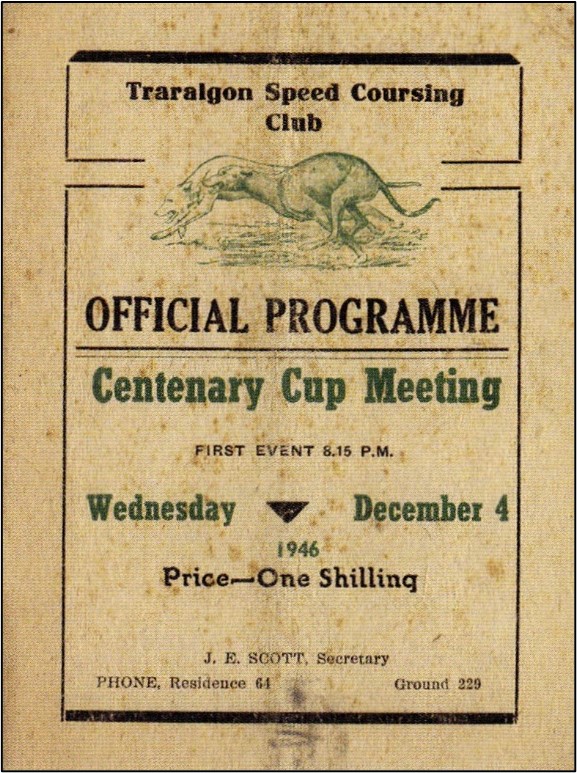
Helen specialized in training "giveaways", greyhounds no one wanted anymore, and which were often mistreated. This may have been one of the reasons for her success as a trainer. One of the greyhounds that she was given, Dark Guinness, had just lost a race and the owner was belting it for losing. He offered the greyhound to Helen. At first, the greyhound would not come out of the kennel so she sat in the kennel with the greyhound and talked to it until it came out and she could begin training it. The greyhound proved to be a winner.
Helen also had more greyhounds that were often a cut above the competition demonstrated by one night when Helen left a greyhound in her car after the race. In those days, the cars were all parked along the edge of track and naturally Helen had left the windows down. When the next race went past, the greyhound jumped out the window, ran onto the track and despite having already run once, was able to overtake all the other greyhounds and win the race. The stewards were not impressed but Helen escaped with a caution.
Club stalwart and font of greyhound wisdom, the late Jack Callaghan also told the Chasing Dreams author he believed that women are more patient with the greyhounds, and this means that they are more successful. He also believed that a nervous owner transmits nervousness down the lead to a greyhound making the greyhound nervous and not able to run at its best. Jack had a good way of judging which greyhound would win the race, "the one leading the trainer out". Both Helen and Jack remember the bad old days when owners were setting greyhounds up to win or lose races. In 1936, Jack's dad had a greyhound called Rory's Boy which had been specially prepared for a race at Traralgon. Often this would involve having a greyhound lose a series of races and then entering it when it was a very good chance of winning. Such practices would often get good odds’ from the bookies and the owner, presumably the only one knowing the greyhound had specially prepared, would back the greyhound at good odds. Unfortunately, someone had beaten Jack's dad for the odds with a big wager and the price had suddenly come down. Jack remembered his father tightening the strap on the greyhound's muzzle so tightly that the greyhound choked and fell over after the first 100 yards. His dad got a six-month suspension and Jack, who was only a boy at the time, was very dark on him for what he did. Undeterred by the suspension, Jack’s dad continued to race but it was a case of different rules for different times.
As time passed, the old track at Park Lane, which either did not have a licence or lost it, had become stagnant. As a result, the greyhound fraternity felt there was a need for another track in Traralgon. There had always been good relations with Sale and Warragul so the idea of a new track in Traralgon was agreed as a good idea for greyhound racing in the Valley. In addition, there was only horse racing at Glenview Park. However, the Shire was keen to have all three codes sharing the same ground. When the track was first built it was out in the sticks but today it has been caught up in the urban expansion of Traralgon and like a number of other clubs now occupies expensive urban land. The inaugural Club President Brian Barry was supported by a committee consisting of the late Leo Barry and Peter Longmore, C. Ayres, R. Dore, W. Harrison, B. Hayes and Tony Tabone.
Barry Longmore’s dad, Leo, had raced greyhounds all his life Leo's boss Brian Barry who owned an engineering company and was very influential in the town was convinced to support the establishment of the new club. Brian was also friends with Don Cooper the Shire engineer who became a great supporter coming to the early committee meetings that were often held in people's homes. Brian Barry became the first President of the new club and was instrumental in organizing Shire support.
Interestingly, neither Brian nor Don ever owned greyhounds.
Barry recalled in 2008 there was a lot of hard work and many trips to the city being involved in getting the licence. Brian Barry provided the workshop where all the railings were made and when there was no work to be done, greyhound work took precedence. Helen Pattle worked long and hard in those early days and her husband Alan supplied timber that went into the grandstand. It is now part of history that when the old town hall was knocked down the bricks were cleaned by the greyhound people and used to build the kennels.
The new greyhound racing circuit was designed to provide two circular ends with initial racing distances being over 513m and 730m. A mechanical lure is driven by an electric motor remotely controlled from the top floor of t h e judge’s tower. The original kennel house at the northern end of the complex was ventilated and kennel operations could be viewed by the public externally from the southern end of the building.
Relationships between the club committee and the ladies committee were not always harmonious. Helen Pattle was Secretary of the ladies committee that ran the canteen and sold party pies, sandwiches, and soft drinks. The club committee was less than impressed to find that the money generated from the sales had been spent to buy a fridge to store the sandwiches. Helen attended the next committee meeting and suggested, as the committee wasn't happy with the way the decisions were being made by the ladies' committee, they could make sandwiches themselves.
Her point was taken, the ladies committee also used to work behind the bar but when the decision was made to pay someone to do it, it finally disbanded. To begin with, the club conducted its race meeting on a Thursday night with a 10 race program Initial stake money was $150 ($720) for a graded race and $250 ($1200) for a Special Event. The Club was serviced by 14 registered bookmakers, 11 betting on local races and three on Sandown. The inaugural greyhound race meeting at the Glenview Park Racing Complex was conducted on 28th Ju n e 1973 by the Latrobe Valley Greyhound Racing Club. The Glenview Park Complex is owned by the Latrobe City and was designed and developed by the City as a centre for the racing of greyhounds, gallopers and trotters.
The Mayor, Cr Cec Beaton JP, opened of the complex acknowledging the work of many dedicated voluntary workers. The opening event was sponsored by the Shire and was a grand occasion. Barry Longmore estimates the first night attendance at 4000 with a great atmosphere and for some time racing on Thursday night was able to attract 14 bookies.
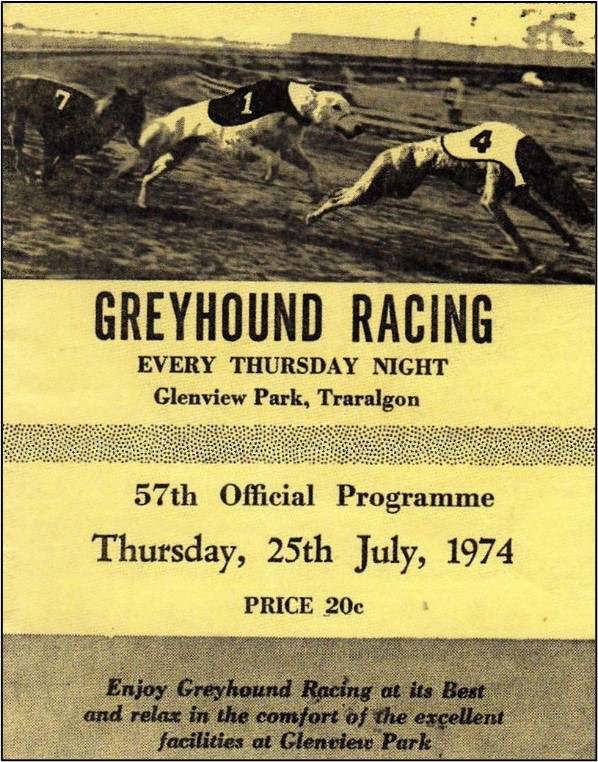
Attendances were such that the club ran two bars. Then like all clubs, the numbers started to fall away until there were only 4 bookies. Original committee member the late Tony Tabone in 2008 for Chasing Dreams remembered opening night as such a big function that his wife, Carole, got a "special hair do." Tony thinks there were so many people there and that you couldn't move for bookmakers who were about 10 feet apart and "Suddenly the locals were watching the greyhounds at Sandown, not simply listening to it on the radio". It was also the first time there were bookies betting off course at Traralgon. In many ways, Tony typifies the country folk who are the backbone of local racing. He only ever raced once at Olympic Park in the city. At the time of his first and only race, Tony believed in the folk myth that greyhounds should not be given water on the day before they raced. He took the greyhound to Olympic Park in a trailer on a very hot day.
The greyhound was the favourite, hit the wall and collapse d 10 yards from the finish while six lengths in front. Tony was invited for a "cup of tea with the stewards" and when asked why the greyhound did not chase, he suggested that it might have been thirsty. History does not record the steward's reaction, but he was fined $20 half a weeks pay for an Electrical Trades Union member working at Hazelwood and never raced at Olympic Park again. It was just too expensive for the struggling country owner with the cost of travel and the entry fees. In the days before the freeway travel was a difficult four-hour drive and on top of that Tony remembered getting lost at St Kilda Junction and having to ask directions to get to Olympic Park.
He had no money on that thirsty greyhound believing that this would "put the mozz on it”. Years later, when he had a Box 1 draw in the final of the Temlee at the Meadows, a race worth $25,000 and which his greyhound subsequently won, he was still not game to bet. During the drought in 2000, Tony had two greyhounds, Smurfs Candidate and Smurfs Explorer that won him $75,000 which was then used to buy feed for the cows. In 2007, he had 41 winners with a strike rate of 18%.
In addition to the dedicated owners, trainers, committee members and volunteers, the club also had its share of so-called colourful characters who have always represented another side of the industry. Brian Helvey was the club steward at both Traralgon and Warragul. Later sacked from both positions, Helvey worked for the Post Masters General's department, when the PMG was responsible for telephone services. Jack Callaghan remembered when he was on duty at the track and responsible for phoning in the betting fluctuations to the bookies at Olympic Park. At the first call of the card, the odds at country clubs would be phoned through to the city clubs where bookies would take off-course bets on country clubs. By the second call, the odds may have fallen, often as a result of increased betting close to the race start.
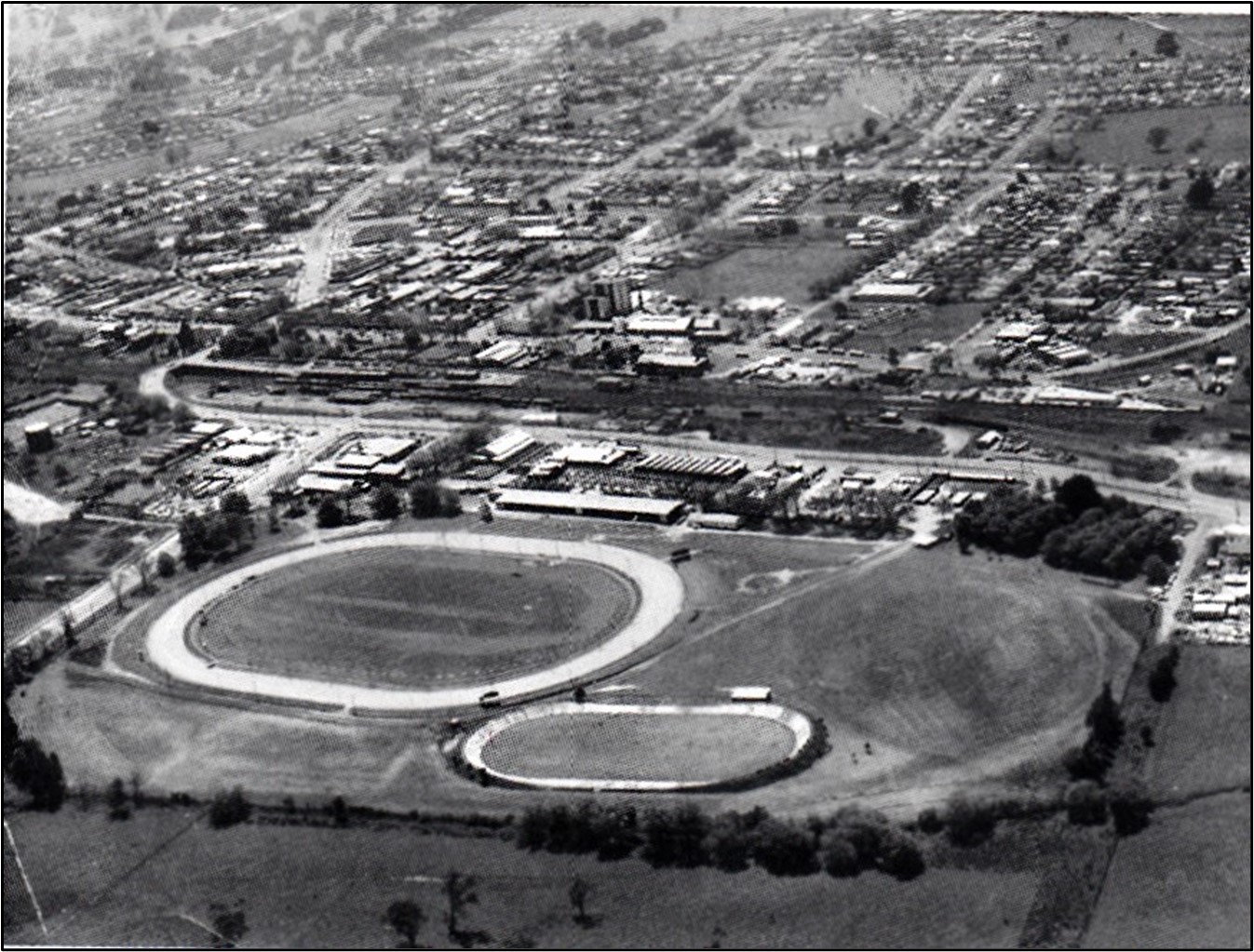 Jack remembered when he was unable to make the fluctuations call because a PMG workman was at the club busy connecting a line, ostensibly to phone in the results through to Adelaide. Jack checked with the then club Secretary, Marg Long who said there was no meeting in Adelaide that day. The PMG workman was actually making sure that the fluctuations would not get through to Olympic Park where he had associates who were betting on the earlier and better odds. Many years later, Jack recalled with satisfaction that he was able to find another phone and make the call.
Jack remembered when he was unable to make the fluctuations call because a PMG workman was at the club busy connecting a line, ostensibly to phone in the results through to Adelaide. Jack checked with the then club Secretary, Marg Long who said there was no meeting in Adelaide that day. The PMG workman was actually making sure that the fluctuations would not get through to Olympic Park where he had associates who were betting on the earlier and better odds. Many years later, Jack recalled with satisfaction that he was able to find another phone and make the call.
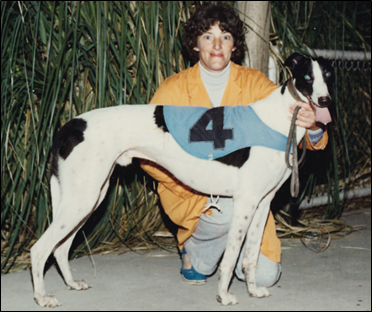
Brian Longmore remembered a small scandal when the winner of the car competition for picking eight winners turned out to the steward 's brother-in-law and the steward (an ex- policeman) had duded the results. However, Traralgon has always been a track supported by local identities. One, the late Des Carlson's early experiences was being invited to the racing at Traralgon by a friend who had six of the eight greyhounds in a race. The other two greyhounds came second and third, leaving his friend the lucky winner. Des had his first winner in 1949 at Kalerie Park in Wonthaggi with his greyhound Alcon, which won five races in nine days.
Victorian Hall of Fame member Marg Thomas has been a club member for many years and on the committee for nine years from 1991, with six of those as President. The club was in financial trouble when she became President, and she describes it as "dormant". She started a raffle to generate more revenue and because numbers were down she was forced to cull staff. In addition, the committee had to volunteer to do much of the work around the club. They bought a stud greyhound, whose services were raffled.
When trying to lift the club finances, Sam Bye introduced an auction conducted after happy hour. He auctioned anything that had been donated, from stud services to umbrellas. The best effort for one of these was $9,000 in one night. When the Traralgon hospital wanted help for the new Cancer Wing, the club put on a picnic day with the GOTBA, which raised $3500 for research.
Like many clubs, Traralgon has had many changes of race day and night moving from Thursday to Monday to Tuesday and then finally Friday twilight. This is to accommodate the complicated coordination of the club meetings across the state. The industry often gets a better percentage return from the off-course TA B with off-course betting at Traralgon is sometimes as much $400,000.
Marg Thomas has noticed that over the years Traralgon has been attracting bigger and better greyhounds. She felt it is necessary to try to attract the bigger trainers to Traralgon and sometimes trainers such as Peter Giles would race his greyhounds there. With many of the bigger trainers using midweek country meetings as trial races for their greyhounds, it has become difficult for the smaller trainer. The dilemma is that the big trainers help lift the standard of racing, but this makes it very difficult for the small "hobby" trainer who now may run up against the bigger trainers at local venues.
In addition to putting the club on a better financial footing, Marg introduced the concept of Memorial races for life members people who had made major contributions to the club. This ran for about four years but to Marg's disappointment has now been somewhat dropped. One of the big disappointments for the club was, when Bill Collins was at GRV, Traralgon was promised $1.4m to build a Tabaret on the condition the Thoroughbreds would raise a similar amount. They were unable to do so and an opportunity that would have made a significant difference to the finances of the club went begging.
In 1982, the committee resolved to change the name of the club to the Traralgon Greyhound Racing Club (TGRC) and was given the opportunity to change its race night from Thursday to Friday. Additional boxes allowed the club to race over 298m and 658m in addition to the 513 and 730 m. The Friday night timeslot remained until mid- 1998 when five of Victorian provincial clubs were allocated twilight time-slots with full Sky Channel coverage. Initially, the club conducted its race meeting in the Tuesday twilight timeslot but after six months changed to a Monday, as problems were apparent with nearby Warragul racing on the same day. The move to twilight racing with Sky Channel coverage has been significant in the progress and viability of the club with turnover increasing by over 100%.
The club has always been well served by voluntary workers who conduct raffles and organise social functions in order to assist the Club's financial viability. Special acknowledgement is made to Lorna Richards and the late Graeme Thomas.
The club in 2014 in conjunction with the GRV and under the guidance of former GRV Employee, Board Member and Cranbourne Manager Hec Caruana built a new track on different part of the site. The old track inside the Racecourse was replaced but by 2018 as it was deemed unsafe and subsequently closed for racing in October of that year. After that closure, the track had been confirmed to be at a state of disrepair. The result of this confirmation meant that the site was redeveloped so as to ensure that a safe, fit for use and clean site was created for greyhounds, participants, Club and GRV staff, plus the general public.

A detailed investigation following the meeting cancellations in 2018 had identified that the drainage issues had permanently compromised the track. GRV worked with the TGRC to agree on an optimal approach for either rectifying or replacing the track, which included a total redesign. With more delays due to Covid-19 work finally got under way in late 2020 and the new radical track design is due to open in late 2021.
The Winning Post Restaurant is on-course and opens for every race meeting. Delicious hot or cold food can be eaten in the air-conditioned dining room while enjoying TAB facilities and Sky Channel coverage. Take away food is also available. The grandstand has a picturesque view of the new track and will be popular with large groups.
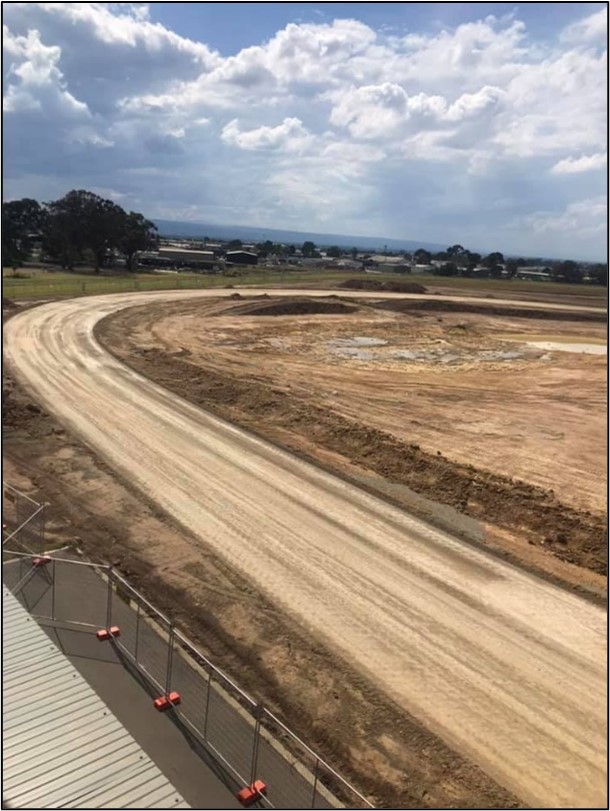
Race night hospitality packages are available for a table of eight including course entry, form guides, a selection of hot/ cold finger food, tea / coffee and a race name for your group. The club can also tailor a package specifically for your group and are always happy to discuss anyones needs. Whether it’s a few drinks for a dozen or a three-course meal for many.
Club Presidents: Brian Barry 1971-1976, Leo Longmore 1976-1978, Peter Longmore 1978-1982, Norm Leahy 1982-1983, Mrs Joan Rodda 1983-1984, Stan Johnson 1984-1987, Barry Longmore 1987-1995, Robert Pahl 1995-1996, Andrew Wood 1996-1999, Margaret Thomas 1999-2006, Ray Cunneen 2006-2008 and Don Hanley 2008- to present.
Fun Facts.
The other unusual occurrence in relation to the cup is it was run over the staying journey early on. For some reason the committee in 1975 decided to conduct the cup over the staying distance of 730 metres after the first cup was run over 513. Jaymar’s Pride recorded 45.06 in winning in 1975. In 1976 the cup was won by outstanding imported stayer Dunmain Scholar in 44.48 and in 1977 another top-class city feature winning stayer Bolt’s Gift won the cup in 44.25. In fact, both Dunmain Scholar and Bolt’s Gift made the final of the 1976 National Distance Championship at Angle Park, won by Bolt’s Gift. The feature in those days was known as the Latrobe Valley Cup which it remained it’s name until changed in 1981.
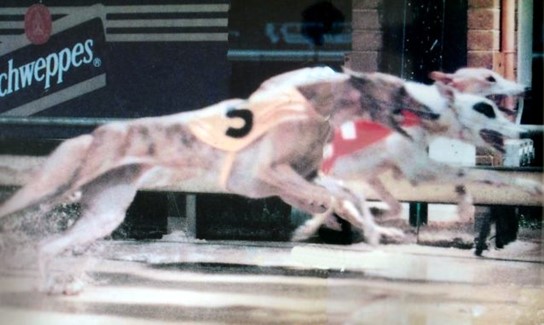
One greyhound in history is famous for sharing the winning spoils by way of a dead heat in not one but two feature finals. The 1992 Traralgon Cup winner Worth Backing he dead heated with Tough As Tears. Then featured in the famous dead heat at Sandown in 1993 in the very first Top Gun staged when he couldn’t be separated from Gold Currency in the amazing three-way finish on a very wet November night. The Traralgon Cup has arguably the best honour roll of any Victorian Country Cup. The list of winners that have also won city Group 1’s and forged great career’s at stud, is as good as you will read. 1983 Drop of Wine, 1991 Malawi’s Prince, 1992 Tough As Tears/ Worth Backing, 1995 Wylie Boy, 2000 Dutchy’s Angel, 2001 Floodfawn, 2002 Elgrando, 2007 Meticulous, 2011 El Grand Senor, 2013 Paw Licking, 2015 Fernando Bale, 2017 Jesaulenko and 2018 Poke The Bear.
